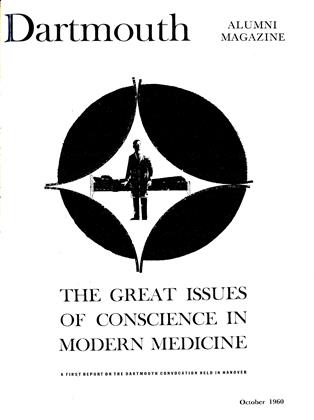By Dr. Seuss (Theodor S. Geisel'25). 63 pp. New York: Beginner Books,1960. $1.95.
This is the third of Dr. Seuss' "Beginner Books," but alas, my first. If you add to that the fact that I have never taught anyone to read (the Dartmouth College students presumably are able to do so upon matriculation), I am unable to make the proper comparisons.
Repetition, at any level, is a basic method of teaching. Dr. Seuss applies this with such skill that it is not obvious or boring. Most of the words have one syllable as is proper. After a slow and steady start which includes a counting exercise, the text begins to play with words. "Dish" or "Look" evolves into a double-page spread of verse which rhymes with the original word. The beginner finds that similar endings with a new commencing letter produce a different word and meaning. Moreover, each series of matching words is repeated in differing combinations, so that the immediate re-use helps in recognition. This seems like a practical, pleasant, and interesting way to enlarge the vocabulary.
The illustrations are characteristic, which means fanciful, enchanting, and perfect for the text, with a small girl and boy helping out the pictures and lending a touch of reality. My lack of knowledge in this field makes me raise the question as to whether the use of typically Dr. Seuss names for his typical animals is helpful to a beginning reader. Each creature does wear his name on his chest but will the child realize that "Zons," "Gox" and "Ish" are words which he will never meet again? The child will never expect to meet these wonderful, imaginative animals, but in the struggle to increase his vocabulary and master the printed word, is it a help or hindrance to meet ones which are manufactured for this book?
Nothing will prevent the child from completely enjoying the entire book which provides such a pleasant introduction to reading.
 View Full Issue
View Full Issue
More From This Issue
-
 Feature
FeatureMedicine's Moral Issues
October 1960 -
 Feature
FeatureA Rare Kind of Movie Star
October 1960 By RAYMOND J. BUCK '52 -
 Feature
FeatureDartmouth's Medical Opportunity
October 1960 By WARD DARLEY -
 Article
ArticleTHE FACULTY
October 1960 By HAROLD L. BOND '42 -
 Class Notes
Class Notes1911
October 1960 By NATHANIEL G. BURLEIGH, ERNEST H. GRISWOLD -
 Class Notes
Class Notes1933
October 1960 By WESLEY H. BEATTIE, GEORGE N. FARRAND
MAUDE D. FRENCH
-
 Letters to the Editor
Letters to the EditorLetters
OCTOBER 1982 -
 Books
BooksTHE ART NOUVEAU
July 1952 By Maude D. French -
 Books
BooksIN CLEAN HAY.
January 1954 By MAUDE D. FRENCH -
 Books
BooksON BEYOND ZEBRA!
December 1955 By MAUDE D. FRENCH -
 Books
BooksHOW THE GRINCH STOLE CHRISTMAS!
March 1958 By MAUDE D. FRENCH -
 Books
BooksDR. SEUSS'S ABC.
NOVEMBER 1963 By MAUDE D. FRENCH
Books
-
 Books
BooksFaculty Publications
May 1934 -
 Books
BooksThe Crookshaven Murder
MARCH, 1928 By F. L. C. -
 Books
BooksCARTAS SOBRE EL ANFITEATRO TARRACONENSE.
JUNE 1972 By JOHN HURD '21 -
 Books
BooksQUICK GUIDE TO CHEESE. HOW TO BUY CHEESE HOW TO KEEP CHEESE HOW TO SERVE CHEESE HOW TO SELECT CHEESE.
November 1973 By John Hurd '21 -
 Books
BooksGEOLOGY OF THE PRESIDENTIAL RANGE
January 1941 By Richard E. Stoiber '32 -
 Books
BooksTHE STORY OF MOUNT WASHINGTON.
June 1960 By STEARNS MORSE

